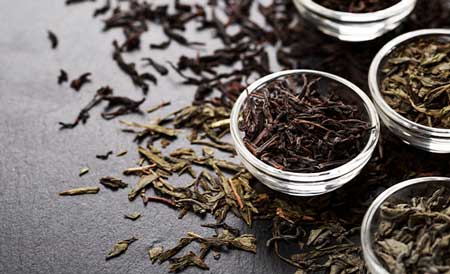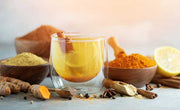What Type of Tea is Best for Me? A Guide to Tea

With all the different kinds of tea available, where do you begin? Before you can determine what tea variety is best for you, let's explore the basics.
What is Tea?
"Real" tea is tea that comes from the Camellia sinensis plant. This plant has its roots in southern China, dating back thousands of years.
There are two main varieties of Camellia sinensis: Camellia sinensis var. sinensis and Camellia sinensis var. assamica.
Camellia sinensis var. sinensis has a gentle taste. It is mainly cultivated in China and other East Asian nations.
Camellia sinensis var. assamica is primarily grown in India. This variety is known for its stronger and more robust flavor.
There are five main varieties of true tea. Each has unique qualities and processing methods that define their distinct characteristics. The basic varieties include:
- Black
- Green
- White
- Oolong
- Pu-erh
The distinct look and taste of each tea variety can be attributed to two primary elements. One factor is the geographical area or terroir where they were cultivated.
Another significant element is the particular processing method employed:
- Were the leaves steamed or pan-fired?
- Did the leaves undergo oxidation or not?
- Were they rolled into tight balls by hand, roughly chopped, or simply air-dried in their natural state?
- When were the leaves harvested, spring, summer, or fall?

Black tea
For those just starting to explore, black tea is often the most popular types of tea. It tends to have a higher caffeine content compared to other loose leaf teas. Yet it contains roughly half the amount found in a cup of coffee.
English Breakfast and Irish Breakfast are popular for their strong flavors. When brewed, they produce a rich, coppery hue and a bold, robust taste.
How is black tea made?
Black tea is made by harvesting the leaves, letting them wilt, and lightly crushing them. Some varieties, like Irish Breakfast, are further broken down using crush-tear-curl (CTC) method. The leaves are then fully oxidized, giving them a brownish-black hue.
Where does black tea come from?
The main countries known for producing black tea are China and India. Black teas from China are typically smoother and more delicate, and are generally enjoyed without milk or sugar. They usually have a marginally lower caffeine content compared to Indian black teas.
Other emerging nations such as Sri Lanka, Nepal, Vietnam, and Kenya are gaining popularity for black tea production. Black tea from India are recognized for their rich, robust body. This makes them ideal for breakfast blends that can handle the addition of milk and sugar.

Green tea
Green tea is also derived from the Camellia sinensis plant. It is known for its light green or yellow brew and delicate flavor. It contains approximately half the caffeine of black tea and a fraction of that found in coffee. Green teas typically have a lighter body and milder taste profile compared to other types of tea.
How is green tea made?
After being picked, the leaves undergo a quick steaming or pan-firing process to stop oxidation. This rapid halt in oxidation is responsible for the vibrant green hue and fresh, vegetal flavor of green tea leaves. The leaves are then shaped and dried through rolling or pressing techniques.
Where does green tea come from?
The main producers of green tea are China and Japan. Chinese green tea is typically pan-fired to halt oxidation. It is known for a more mild flavor than the Japaneses variety, and produce a light golden hue when brewed. Some well-liked green tea options are Dragon Well and Gunpowder tea.
In comparison, Japanese uses the steaming method immediately after the leaves are picked to stop oxidation. It has a subtle savory taste, and brews a pale emerald green color. Some Japanese leaves are shaded before harvesting to boost levels of chlorophyll, caffeine, and l-theanine.

What about Matcha?
Matcha is a finely ground Japanese green tea. People love Matcha for its velvety texture and complex flavor profile. It offers a balance of umami and a subtle touch of bitterness.
Ceremonial grade matcha is best enjoyed by itself, while barista grade is great for making smoothies or matcha lattes. Chefs use culinary grade matcha for recipes and desserts.
How is matcha made?
Farmers shade tea plants for at least three weeks before harvesting them to make matcha. This shading technique boosts the chlorophyll content in the plants, resulting in a vibrant emerald green hue. It also enhances the levels of caffeine and l-theanine, contributing to its distinctive umami taste. After drying, workers finely grind the leaves into a powder using stone mills.
Where does matcha come from?
The origins of matcha can be traced back to China during the Tang Dynasty. It was introduced later during the 12th century to Japan by Chinese monks, along with Buddhism.
The ceremonial use of matcha for Japanese tea ceremonies rapidly gained popularity among Japanese monks. The popularity then spread to the upper classes by the 15th century.

White tea
White tea is refined, and lightly processed. It is highly desired and appreciated by both enthusiasts and newbie drinkers. It has a delicate body and a subtle taste with a refreshing, pure aftertaste. White tea usually has less caffeine, but some silver tip types may have a bit more caffeine.
How is white tea made?
White tea undergoes very little processing before it is dried and packed. Specific types like Silver Needle are harvested from the plant's young tips and buds, before they fully mature into leaves.
Tea produced from the tips contains more caffeine than mature leaves which are plucked after the leaves have opened and expanded.
Where does white tea come from?
White tea has a deep rooted past in the Fujian region of China. Other unique white teas are also grown in regions such as Nepal, Taiwan, and Sri Lanka.

Oolong tea
Oolong falls in the middle of the oxidation spectrum between black and green teas. It can vary in oxidation levels from 10-80%, resulting in a brew color that ranges from pale yellow to rich amber. Oolong can be steeped multiple times. Each cup offers unique flavors and characteristics.
How is Oolong tea made?
Oolong teas go through a process of harvesting, withering, and partial oxidation.
The level of oxidation in oolong tea can vary, from light to heavy depending on the type, similar to black tea. Tea makers hand-roll some oolongs into compact balls before drying and preparing them for packaging.
Some oolongs, like Milk Oolong, come from a special plant that has been cultivated for years to create unique flavors in the tea.
Where does Oolong tea come from?
The main producers of oolong tea are China and Taiwan. In China, oolong is grown in regions such as the Wuyi Mountains and Anxi in Fujian province, as well as Guangdong province. Taiwan, a small island near China, is known for its unique oolong varieties, like the popular Milk Oolong.
Pu-erh tea
Pu-erh is a matured leaf that has undergone partial fermentation, resembling black tea in taste. When brewed, Pu-erh produces a reddish brown-black color with a robust body and a flavorful, earthy profile. Its caffeine level is similar to black tea, but lower than coffee.
How is pu-erh tea made?
Pu-erh tea begins in a process similar to green tea. After the leaves are picked, they are steamed or pan-fired to stop oxidation. Then the leaves are shaped and dried. The final stage is the fermentation process that sets pu-erh apart from other green tea.
Sheng pu-erh is made using a traditional technique, where leaves are aged slowly over time. Shou pu-erh is produced using a more modern technique that accelerates fermentation.
Both types of pu-erh tea are aged for a few years to enhance their strong and earthy flavors.
Where does pu-erh tea come from?
Pu-erh tea was first produced in the Chinese city of Pu-erh, located in Yunnan province. This region remains its main production area. Other provinces like Hunan and Guangdong also make aged teas. However, Yunnan province is the only place where teas can be officially called pu-erh.

Non-caffeinated Tea Types
Herbal tea
Not originating from the Camellia sinensis plant, herbal teas are not considered to be a true tea. Herbal teas can be found as single ingredient, such as Chamomile or Peppermint, or as delicious blends. These herbal infusions or tisanes are composed of a blend of different fruit, flowers, herbs and spices.
People often search out herbal blends for their medicinal properties. Herbal blends can be a natural remedy for ailments such as sore throats or upset stomachs.
While herbal tisanes are typically caffeine free, there are some exceptions.
Mate tea
Mate is an example of an herbal infusion that contains a high level of caffeine. Mate is produced from a plant native to South America. Traditional preparation is in a hollow gourd. It is then consumed through a bombilla, or filtered straw.
It is a South American tradition to share the same gourd among friends. But you don't have to use a gourd. Mate can also be easily steeped just like other loose leaf tea, in an infuser, basket, or teapot.
Rooibos teas
Native to a South Africa, Rooibos is an herbal tea also known as red tea or red bush tea. Rooibos has a pleasant sweetness and is naturally caffeine free.
Rooibos is delicious enjoyed on its own or with a splash of milk. Rooibos is also used in delicious flavored blends like Cinnamon Rooibos or Vanilla Chai.
So, what type of tea is best for you?
We hope these basic categories make it easier to understand how a tea will taste. Your personal flavor preference will help you determine the type of tea that is best for you. Whether you’re just beginning to learn or are a dedicated tea drinker, always keep exploring new teas. There's a flavorful world out there waiting for you!





